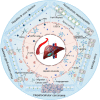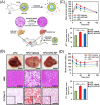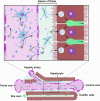Polymeric nanomedicines for the treatment of hepatic diseases
- PMID: 36402994
- PMCID: PMC9675156
- DOI: 10.1186/s12951-022-01708-y
Polymeric nanomedicines for the treatment of hepatic diseases
Abstract
The liver is an important organ in the human body and performs many functions, such as digestion, detoxification, metabolism, immune responses, and vitamin and mineral storage. Therefore, disorders of liver functions triggered by various hepatic diseases, including hepatitis B virus infection, nonalcoholic steatohepatitis, hepatic fibrosis, hepatocellular carcinoma, and transplant rejection, significantly threaten human health worldwide. Polymer-based nanomedicines, which can be easily engineered with ideal physicochemical characteristics and functions, have considerable merits, including contributions to improved therapeutic outcomes and reduced adverse effects of drugs, in the treatment of hepatic diseases compared to traditional therapeutic agents. This review describes liver anatomy and function, and liver targeting strategies, hepatic disease treatment applications and intrahepatic fates of polymeric nanomedicines. The challenges and outlooks of hepatic disease treatment with polymeric nanomedicines are also discussed.
Keywords: Hepatic fibrosis; Hepatitis B virus; Hepatocellular carcinoma; Host-versus-graft disease; Liver targeting; Nonalcoholic steatohepatitis; Polymeric nanomedicines.
© 2022. The Author(s).
Conflict of interest statement
The authors declare no conflict of interest.
Figures









Similar articles
-
Nanomedicines: a theranostic approach for hepatocellular carcinoma.Artif Cells Nanomed Biotechnol. 2018 Jun;46(4):680-690. doi: 10.1080/21691401.2017.1374282. Epub 2017 Sep 8. Artif Cells Nanomed Biotechnol. 2018. PMID: 28884605 Review.
-
Association of nonalcoholic fatty liver disease and liver cancer.World J Gastroenterol. 2015 Jan 21;21(3):913-8. doi: 10.3748/wjg.v21.i3.913. World J Gastroenterol. 2015. PMID: 25624725 Free PMC article.
-
Liver pathology in obesity.Semin Liver Dis. 2004 Nov;24(4):363-70. doi: 10.1055/s-2004-860865. Semin Liver Dis. 2004. PMID: 15605304 Review.
-
Next-Generation Polymeric Nanomedicines for Oncology: Perspectives and Future Directions.Macromol Rapid Commun. 2020 Sep;41(18):e2000319. doi: 10.1002/marc.202000319. Epub 2020 Aug 7. Macromol Rapid Commun. 2020. PMID: 32767396
-
Development of a novel mouse model of hepatocellular carcinoma with nonalcoholic steatohepatitis using a high-fat, choline-deficient diet and intraperitoneal injection of diethylnitrosamine.BMC Gastroenterol. 2016 Jun 13;16(1):61. doi: 10.1186/s12876-016-0477-5. BMC Gastroenterol. 2016. PMID: 27296438 Free PMC article.
Cited by
-
MiRNAs in Alcohol-Related Liver Diseases and Hepatocellular Carcinoma: A Step toward New Therapeutic Approaches?Cancers (Basel). 2023 Nov 23;15(23):5557. doi: 10.3390/cancers15235557. Cancers (Basel). 2023. PMID: 38067261 Free PMC article. Review.
-
Advances of Nanotechnology in the Diagnosis and Treatment of Hepatocellular Carcinoma.J Clin Med. 2023 Oct 31;12(21):6867. doi: 10.3390/jcm12216867. J Clin Med. 2023. PMID: 37959332 Free PMC article. Review.
-
Nanoparticles and Nanomaterials: A Review from the Standpoint of Pharmacy and Medicine.Pharmaceutics. 2025 May 16;17(5):655. doi: 10.3390/pharmaceutics17050655. Pharmaceutics. 2025. PMID: 40430945 Free PMC article. Review.
-
Development of a nanoparticle-based tendon-targeting drug delivery system to pharmacologically modulate tendon healing.Sci Adv. 2024 Jun 21;10(25):eadn2332. doi: 10.1126/sciadv.adn2332. Epub 2024 Jun 19. Sci Adv. 2024. PMID: 38896625 Free PMC article.
References
-
- Asrani SK, Devarbhavi H, Eaton J, Kamath PS. Burden of liver diseases in the world. J Hepatol. 2019;70(1):151–71. - PubMed
-
- Llovet JM, Kelley RK, Villanueva A, Singal AG, Pikarsky E, Roayaie S, et al. Hepatocellular carcinoma. Nat Rev Dis Primers. 2021;7(1):6. - PubMed
-
- Geissler EK, Schlitt HJ. Immunosuppression for liver transplantation. Gut. 2009;58(3):452–63. - PubMed
Publication types
MeSH terms
Substances
Grants and funding
- 81901627/National Natural Science Foundation of China
- 52173145/National Natural Science Foundation of China
- U20A20360/National Natural Science Foundation of China
- 20210101063JC/Jilin Provincial Science and Technology Development Program
- 2022226/Youth Innovation Promotion Association of the Chinese Academy of Sciences
LinkOut - more resources
Full Text Sources
Medical

